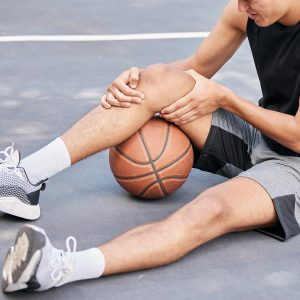March Madness—What You Need to Know About Basketball Injuries

2023 March Madness has lived up to its name. The brackets are in—most are busted. The Final Four is set. And as the athletes compete at the top of their game on minimal rest, we wait to see who will be crowned NCAA champions. And as we’ve seen, the game comes with risks for everyone who takes the court.
Common Basketball Injuries
Basketball requires skill and coordination to run, shoot, pass, dribble, and jump. Orlin & Cohen’s Dr. James Curley, PT, DPT, ATC knows from a lifetime of play including four years in college that, “Like any sport, athletes can suffer injuries—contact and noncontact. It’s important to understand the risks and take steps to avoid serious injury while enjoying the game.” Below are a few common injuries that affect basketball players.
Ankle sprain
The ankles help maintain stability during all different types of movements on the court. And they are often vulnerable to injury.
Although most ankle sprains are minor and require only a few days or weeks to heal, additional support may be required to continue play. This may mean wearing an ankle brace or having your ankle taped by your athletic trainer to improve the stability of the joint.
Achilles rupture
Especially while jumping and during acceleration and deceleration, there is pressure put on the Achilles tendon at the back of your ankle. Because of the amount of force during these movements, there is the potential for this tendon to rupture. The athlete will feel a “pop” in the back of the ankle as well as increased pain and pressure. Many individuals describe this injury as if they were struck in the back of their calf with a baseball bat. When this happens, the person has difficulty walking because they are unable to push off the ball of their foot.
Orlin & Cohen has Long Island’s most experienced foot and ankle subspecialists. If an Achilles rupture is suspected, we’ll begin by evaluating your condition using our in-house diagnostic testing along with an examination. Confirmation is made with an MRI. Depending on the severity of the injury to the Achilles, treatment can vary between operative and nonoperative methods. Both require the athlete to refrain from play and seek rehabilitation through an athletic trainer or physical therapist.
ACL tear
In basketball, it is crucial to be able to pivot, change speeds, and accelerate and decelerate quickly. The ACL (anterior cruciate ligament) is connected to the femur and tibia and is responsible for maintaining the stability of the knee during these movements. Excessive stress on the ACL could cause a tear.
Typically, when this occurs, individuals may feel or hear a “pop” followed by immediate, intense pain. Afterward, the knee will likely feel unstable with “shifting” or “slipping” in the joint. Athletes will need to discontinue play.
Diagnosis of an ACL tear, like an Achilles rupture, is made using special testing that is performed by an athletic trainer, physical therapist, or an orthopedic MD and confirmed with an MRI. Treatment consists of surgical ACL reconstruction followed up by extensive physical therapy to return to play.
Jumper’s knee
Jumping is a vital fundamental skill used in basketball. Jumping, combined with decelerating, backpedaling, and moving laterally all contribute to additional stress on the patella tendon, which is located at the front of the knee and attaches the patella bone to the tibia; allowing the knee to flex and extend.
Patella tendonitis results in pain, irritation, and swelling along the tendon. It is prevalent in players of all ages; however, it is more commonly seen in boys and girls from the ages of 10–16 years old during growth spurts. When the bones and tendons grow quickly, it prevents the tendons from gaining adequate strength.
Patella tendonitis is diagnosed based on symptoms. A professional can also use special testing and MRIs to rule out other diagnoses. Treatment involves a physical therapist or an athletic trainer who will facilitate an exercise plan to increase strength and flexibility and also educate players about the importance of body mechanics to help improve symptoms.
If any of these injuries are suspected, a proper evaluation and treatment by a licensed professional are warranted to ensure the best outcome and to get players back on the court.
How to Avoid Basketball Injuries
While many injuries on the court are a matter of in-game circumstances, incidental contact, or just plain bad luck, there are steps ball players can take to help reduce the risk of injury.
Wear the proper shoes
Every athlete is different and each one knows best what shoes are comfortable and offer the most support for their style of game. High-top basketball shoes are common since they add support to the ankles. Good, sturdy shoes can also help reduce impact stress on the knees, hips, and back.
Warm up
Go to any game early and you’ll witness very deliberate and choreographed pregame warm-up routines. These can involve stretching, shooting, passing, even sprinting and one-on-one drills. The purpose is to get the body loose and ready for game action and to reduce the risk of injury from playing cold.
Use proper technique
From a very young age, basketball players are taught how to dribble and shoot and all the other basics. But staying safe from injury requires more, including understanding positioning, coverage, and anticipation to keep the player in the right place on the court for the situation—and help reduce the risk of injury.
Stretch after
When the game is over and the handshake line ends, basketball players have more work to do. Like runners and athletes across sports, it’s important to “warm down” to help avoid muscle tightening and other injuries. Athletic trainers and team managers often work with players to ensure they adhere to a proper postgame routine.
If you’re injured on the court—or have any nagging aches and pains related to your game—speak to a fellowship-trained, Orlin & Cohen specialist. Visit OrlinCohen.com today to get started. It could mean a better outcome tomorrow. It’s easy and convenient to get the care you need with same-day appointments and walk-in, after-hours care.



